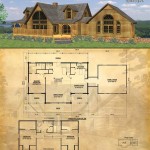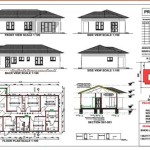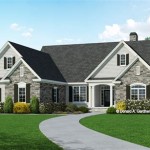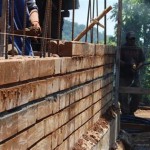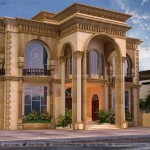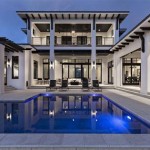4 Bedroom House Plan Cost: A Comprehensive Guide
The construction of a new home is a significant financial undertaking, and understanding the various costs involved is crucial for successful project management. A 4-bedroom house plan is a popular choice for families, offering sufficient living space and accommodating various lifestyle needs. However, the overall cost of executing such a plan can vary significantly based on numerous factors. This article provides a detailed exploration of the costs associated with constructing a 4-bedroom house, delving into the key components and influences that impact the final budget.
Before embarking on a construction project, it is essential to have a clear understanding of the different stages involved and the associated expenses. The planning phase, including architectural design and blueprint creation, is a critical first step. This determines the layout, style, and technical specifications of the house. Following the planning, the construction phase encompasses site preparation, foundation laying, framing, roofing, installation of utilities (plumbing, electrical, HVAC), interior finishing (walls, flooring, fixtures), and landscaping. Each of these stages contributes to the overall cost, and careful budgeting is essential for staying within financial constraints.
Several factors contribute to the overall cost of a 4-bedroom house. These factors can be broadly categorized into location, materials, labor, design complexity, and unforeseen expenses. Location plays a significant role as land prices, labor costs, and material availability can vary significantly from one region to another. The selection of materials, ranging from basic to high-end options, directly impacts the budget. Labor costs depend on the skill level and availability of contractors. Complex designs often require specialized expertise and more time, leading to higher costs. Finally, it is prudent to factor in a contingency fund to cover unexpected expenses that may arise during construction.
Key Cost Components of a 4-Bedroom House
Understanding the individual cost components of a 4-bedroom house is vital for accurate budgeting and cost management. These components can be broken down into several key areas, each contributing significantly to the overall expense.
Land Acquisition: The cost of the land is often the most significant initial expense. Land prices are highly variable and depend on factors such as location, size, zoning regulations, and accessibility. Prime locations in urban areas typically command higher prices than rural or suburban areas. Before purchasing land, it is crucial to conduct thorough research and assess its suitability for building, considering factors such as soil conditions, topography, and environmental regulations. Surveying, legal fees, and transfer taxes also contribute to the overall cost of land acquisition.
Architectural Design and Blueprints: Engaging an architect to design the house and create detailed blueprints is essential for ensuring structural integrity, functionality, and aesthetic appeal. Architectural fees typically range from 5% to 15% of the total construction cost, depending on the complexity of the design and the architect's experience. Blueprints provide detailed instructions for the construction team, ensuring accurate implementation of the design. The cost of blueprints includes expenses for drafting, engineering calculations, and any necessary revisions. Selecting a pre-designed house plan can reduce costs, but may not offer the same level of customization.
Site Preparation: Preparing the site for construction involves clearing vegetation, leveling the ground, and ensuring proper drainage. The cost of site preparation can vary depending on the existing conditions of the land. If the site requires extensive excavation, grading, or removal of hazardous materials, the costs will be higher. Soil testing is also an important step in site preparation, as it helps determine the soil's load-bearing capacity and informs the foundation design. Proper site preparation is critical for ensuring the stability and longevity of the house.
Foundation: The foundation is the base of the house and provides structural support. The type of foundation used (e.g., slab-on-grade, crawl space, basement) depends on the soil conditions, climate, and design preferences. Slab-on-grade foundations are generally the least expensive, while basements are the most expensive due to the additional excavation and concrete work required. The cost of the foundation also includes expenses for concrete, reinforcing steel, formwork, and waterproofing. Ensuring a properly constructed foundation is critical for preventing structural problems in the future.
Framing: Framing involves constructing the skeletal structure of the house, including the walls, floors, and roof. The cost of framing depends on the type of framing material used (e.g., wood, steel), the complexity of the design, and the labor costs. Wood framing is the most common and generally the least expensive option. Steel framing is more durable but also more expensive. The cost of framing also includes expenses for lumber, nails, fasteners, and sheathing. Proper framing is essential for ensuring the structural integrity and stability of the house.
Roofing: The roof protects the house from the elements and is a critical component of the building envelope. The cost of roofing depends on the type of roofing material used (e.g., asphalt shingles, tile, metal), the roof's slope, and the complexity of the design. Asphalt shingles are the most common and generally the least expensive option. Tile and metal roofs are more durable but also more expensive. The cost of roofing also includes expenses for underlayment, flashing, and labor. A well-installed roof is essential for preventing water damage and maintaining the house's energy efficiency.
Exterior Finishing: Exterior finishing includes siding, windows, doors, and trim. The cost of exterior finishing depends on the materials selected and the complexity of the design. Siding options include wood, vinyl, brick, and stucco, each with varying costs and aesthetic qualities. Window and door prices depend on the material (e.g., wood, vinyl, aluminum), the size, and the energy efficiency rating. Proper exterior finishing is essential for protecting the house from the elements and enhancing its curb appeal.
Plumbing: Plumbing involves installing the water supply and drainage systems, including pipes, fixtures, and appliances. The cost of plumbing depends on the number of bathrooms and kitchens, the complexity of the layout, and the quality of the fixtures. Plumbing costs also include expenses for permits, inspections, and labor. Proper plumbing is essential for ensuring a safe and functional water system and preventing leaks and water damage.
Electrical: Electrical work involves installing the wiring, outlets, switches, lighting fixtures, and electrical panel. The cost of electrical work depends on the size of the house, the complexity of the layout, and the quality of the fixtures. Electrical costs also include expenses for permits, inspections, and labor. Proper electrical wiring is essential for ensuring a safe and reliable power supply and preventing electrical hazards.
HVAC: HVAC (Heating, Ventilation, and Air Conditioning) involves installing the heating, cooling, and ventilation systems. The cost of HVAC depends on the size of the house, the climate, and the type of system installed (e.g., forced air, heat pump, geothermal). HVAC costs also include expenses for ductwork, thermostats, and labor. An efficient HVAC system is essential for maintaining a comfortable indoor environment and reducing energy consumption.
Interior Finishing: Interior finishing includes drywall, insulation, flooring, painting, trim, and fixtures. The cost of interior finishing depends on the materials selected and the complexity of the design. Drywall and insulation provide thermal and acoustic comfort. Flooring options include carpet, hardwood, tile, and laminate, each with varying costs and aesthetic qualities. Painting and trim enhance the interior aesthetic. Fixtures include lighting, faucets, and hardware. Proper interior finishing is essential for creating a comfortable and aesthetically pleasing living space.
Appliances: Appliances include refrigerators, ovens, dishwashers, washing machines, and dryers. The cost of appliances depends on the brand, the features, and the energy efficiency rating. Appliance packages are often available at discounted prices. Selecting energy-efficient appliances can reduce long-term operating costs.
Landscaping: Landscaping involves planting trees, shrubs, and grass, as well as installing walkways, patios, and fences. The cost of landscaping depends on the size of the yard, the complexity of the design, and the materials selected. Landscaping can enhance the curb appeal of the house and provide outdoor living space.
Permits and Fees: Building permits are required for most construction projects and ensure compliance with building codes and regulations. Permit fees vary depending on the location and the size of the project. Other fees may include impact fees, inspection fees, and utility connection fees.
Factors Influencing the Cost of Construction
Beyond the individual cost components, several broader factors can significantly influence the overall cost of constructing a 4-bedroom house. Understanding these factors helps in making informed decisions during the planning and construction phases.
Location: As previously mentioned, location is a primary driver of construction costs. Land prices, labor rates, and material availability vary significantly across different regions. Urban areas generally have higher construction costs than rural areas due to higher land prices and labor rates. Building codes and regulations also vary by location, which can impact the cost of construction. Conducting thorough research on local market conditions is essential for accurate budgeting.
Material Choices: The selection of materials has a direct impact on the cost of construction. Choosing basic, readily available materials will generally be less expensive than selecting high-end, custom materials. For example, using asphalt shingles instead of tile for roofing, or vinyl siding instead of brick, can significantly reduce costs. Balancing cost considerations with durability and aesthetic preferences is important. Exploring alternative materials and value engineering options can help reduce costs without compromising quality.
Design Complexity: Complex architectural designs with intricate details and unusual features can significantly increase construction costs. Simple, straightforward designs are generally less expensive to build. Features such as vaulted ceilings, curved walls, and custom millwork require specialized labor and materials, which can add to the cost. Simplifying the design without sacrificing functionality and aesthetic appeal can help reduce costs. Utilizing standard building techniques and materials can also contribute to cost savings.
Labor Costs: Labor costs are a significant component of the overall construction cost. Labor rates vary depending on the skill level and availability of contractors. Hiring experienced and qualified contractors is important for ensuring quality workmanship and preventing costly mistakes. However, it is also important to obtain multiple bids from different contractors to ensure competitive pricing. Negotiating labor rates and understanding the scope of work included in the contract can help manage labor costs.
Timing: The timing of the construction project can also impact costs. Construction costs tend to fluctuate with market conditions. During periods of high demand, labor and material costs may increase. Seasonal factors, such as weather conditions, can also affect construction schedules and costs. Building during the off-season or planning ahead to avoid peak demand periods can potentially reduce costs.
Unforeseen Expenses: It is prudent to factor in a contingency fund to cover unforeseen expenses that may arise during construction. These expenses can include unexpected site conditions, material price increases, or changes to the design. A contingency fund of 5% to 10% of the total construction cost is generally recommended. Having a contingency fund in place can help prevent financial setbacks and ensure the project is completed on time and within budget.
Strategies for Managing Construction Costs
Effective cost management is essential for staying within budget during the construction of a 4-bedroom house. Implementing various strategies can help minimize costs without compromising quality and functionality.
Detailed Planning and Budgeting: A detailed plan and budget are crucial for managing construction costs. This includes creating a comprehensive list of all expenses, obtaining accurate estimates, and tracking expenses throughout the project. Regular monitoring of the budget and comparison to actual expenses can help identify potential cost overruns early on. Adjustments can then be made to stay within budget. Using project management software or tools can help streamline the budgeting and tracking process.
Value Engineering: Value engineering involves finding ways to reduce costs without sacrificing quality or functionality. This can include exploring alternative materials, simplifying the design, or streamlining the construction process. For example, using engineered wood products instead of solid lumber, or choosing standard-size windows and doors, can reduce costs without compromising performance. Value engineering requires careful analysis and collaboration between the architect, contractor, and homeowner.
Competitive Bidding: Obtaining multiple bids from different contractors is essential for ensuring competitive pricing. The bidding process allows for comparing prices and services offered by different contractors. It is important to carefully review each bid and ensure that all aspects of the project are included. Checking references and verifying licenses and insurance is also important before selecting a contractor. Negotiating the terms of the contract and clarifying any ambiguities can help prevent disputes and cost overruns.
Owner Involvement: Active owner involvement in the construction process can help identify potential cost savings and ensure that the project stays on track. Regularly communicating with the architect and contractor, attending site meetings, and monitoring progress can help prevent misunderstandings and costly mistakes. Making timely decisions and providing clear instructions can also help avoid delays and cost overruns. Owner involvement can also include performing some of the work themselves, such as painting or landscaping, to reduce labor costs.
Phased Construction: Phased construction involves breaking the project down into smaller phases and completing each phase separately. This can help manage cash flow and allow for making adjustments to the budget as the project progresses. For example, completing the foundation and framing before starting the interior finishing can provide more flexibility in managing costs. Phased construction can also allow for prioritizing certain aspects of the project and deferring others to a later date.
Energy-Efficient Design: Incorporating energy-efficient design features can reduce long-term operating costs. This can include using energy-efficient windows and doors, insulating walls and ceilings, and installing a high-efficiency HVAC system. Energy-efficient appliances and lighting can also reduce energy consumption. While energy-efficient features may have a higher initial cost, they can result in significant savings on utility bills over the long term. Government incentives and rebates may also be available for energy-efficient construction.

Building On The Affordable House Plans Of 2024 Houseplans Blog Com

Est House Plans To Build Simple With Style Blog Eplans Com

House Plans 14 4x10 With 4 Bedrooms Samhouseplans

Cost Effective 4 Bedroom Modern Home In Low Budget Free Plan Kerala Plans House

Cost Of Building A 4 Bedroom House

Amazing 4 Bedroom House Plans Home Designs Nethouseplans

29 Lakhs Cost Effective 4 Bedroom Home With Free Plan Kerala Plans Building House Affordable Model

4 Bedroom House Plan In Village Bhk Home Plans Simple Low Budget

4 Bedroom House Designs In Kenya To Inspire Your Next Build Co Ke

Low Cost Single Story 4 Bedroom House Floor Plans Country Farm 2200 Sf One Level

